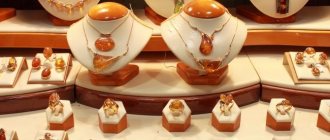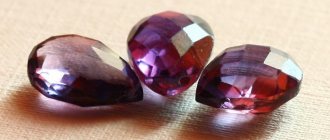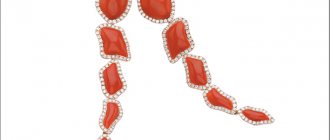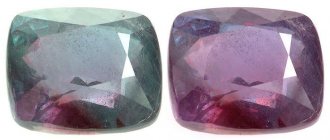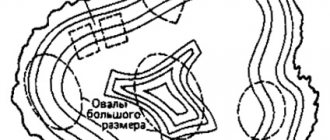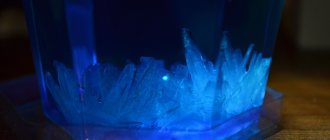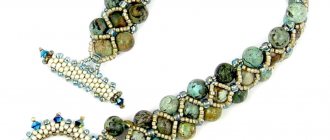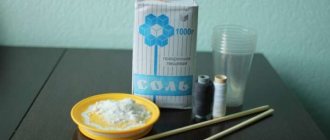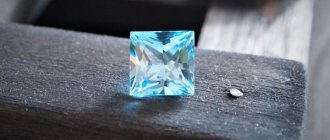Translation from the GIA website
Quite often, the buyer of jewelry and precious stones comes across stones that have been pre-treated to improve their characteristics.
In some sense, all gemstones are processed after they are removed from the mine in order to prepare them for use in jewelry. Routine procedures for such preparation: cutting, cutting, polishing. However, in addition to these traditional methods, you can also improve the color and clarity of the stone using various methods. At the same time, the durability of the stone increases (or decreases). It is quite difficult to determine whether a stone has been subjected to such treatment even for a gemologist, not to mention ordinary buyers. Therefore, it is necessary to provide legislation requiring the seller of jewelry and stones, including retailers, to disclose the procedure for improving the stones they sell. The absence of this information may lead a person to believe that a particular gemstone is of higher quality than it actually is and therefore more valuable and worth more. In addition, with normal use of jewelry, the effect of such improvement can be permanent, long-term or short-term. On top of this, treated stones may require special care from their owner. In the United States, the Federal Trade Commission has established a number of requirements for trade in processed stones. Other countries around the world either follow these rules or set their own. In addition, organizations such as the American Gem Trade Association (AGTA), the International Colored Gemstone Association (ICA), and the World Jewelery Confederation (CIBJO) have also formulated their requirements for the trade in treated stones, which all their members must adhere to. The following are all currently known methods of treating gemstones. Of course, new ways of improving gemstones are emerging all the time, and their discovery is an important part of ongoing gemological research.
Bleaching
The use of chemicals to change or reduce the colors or porosity of the stone.
The most common bleached gemstones are:
Jadeite - Jadeite is often acid bleached to remove the unwanted brown component from the material. Bleaching of jadeite is usually part of a two-step process. Since the material becomes porous or brittle along the cracks after acid bleaching, it is then treated with a polymer impregnation to fill the cavities and achieve the best appearance.
These areas in jadeite show the material before and after bleaching.
Pearls - All types of pearls are usually bleached with hydrogen peroxide to lighten and improve the uniformity of their color.
Cultured pearls are usually bleached to achieve uniform color.
Detection
Whitening in a one-step process is almost undetectable in most cases. The second step, impregnation of polymer compounds, is easier to detect in a qualified gemological laboratory using magnification and more advanced analytical techniques.
In trade
Most often found in pearls and jadeite.
Durability Factor
Acid bleaching causes disturbances in the structure of most materials, making the materials brittle and vulnerable to breakage. In most cases, bleaching is accompanied by an impregnation treatment to improve strength and fix the perceived color.
Special care requirements
Bleached gemstones tend to be more fragile and more porous and thus more absorbent of human sweat and grease, oil and other liquids. Bleached pearls should be stored in a soft and dry environment to avoid surface damage.
Surface coating
Changing the appearance of a gemstone by applying a coloring agent to the back surface of the stone (a treatment technique known as "backing") or painting over part of the stone, as well as the entire surface of the stone, to change its color.
The most common coated stones
Diamonds. Thin film coatings are applied to diamonds to change their color. A fairly effective method is to apply liquid ink from a marker to the girdle of the diamond, as a result of which, when looking at the stone from above, the color of its face will depend on the color of the ink. Another method is to apply thin films based on metal oxides.
The intense pink color of these three diamonds is the result of the surface coating.
Tanzanite. This method is rarely used for tanzanites. Tanzanites are plated to enhance the intensity of their blue-violet color.
Classic tanzanite exhibits a deep purple-blue color (left). Pale tanzanite and other pale stones are sometimes coated with ink to try to deepen and enhance their color (right).
Topaz. Some colorless topazes are coated with metal oxides to create the appearance of many different colors. In the past, such treatments were often described as a form of "diffusion" of a chemical into the surface of the gemstone, but this was incorrect as in most cases the color remains on a thin film adhering to the surface of the gemstone.
Some natural topazes are colorless (top two), but they can be coated with metal oxides to produce a variety of metallic colors (bottom).
Coral. It has been reported that some black corals (also known as rugosa) were bleached and then coated with a relatively thick layer of synthetic resin to protect them and enhance the color.
This golden coral is created through a two-step process: first, to bleach the dark color, the coral branch was partially dipped in bleach to create a golden color, then the coral was coated with resin to protect and deepen the tone.
Pearl. It has been reported that some pearls have been treated with a colorless hard coating to improve their durability.
Quartz. From time to time, quartz is coated with metal oxides to create colors rarely seen in natural quartz.
Vacuum deposition can produce thin films of metal oxides on many precious stones. This thin layer can change color depending on the nature of the metal oxide on the quartz crystals or already faceted quartz.
Durability Factor
Since the coating is softer than stone and may not adhere very firmly to the stone, the surface of a coated stone is susceptible to any kind of scratches, especially on facet edges and corners. Handling such stones requires caution and avoiding the use of any abrasives or other hard objects.
Detection
Easily detected by a gemologist unless the coating is done to improve the durability of the stone.
In trade
Occasionally occurs in some gemstones.
Care requirements
When not being worn, gemstone items should be wrapped in soft cloth and stored in a dry place.
Video about cutting stone
The stands and supports of the side table should be covered with felt or rubber to insulate the machine
You will also need a tray of water to cool the cutting wheel, which we will place under the side table. To reduce friction when cooling, use a soap solution. Place another pan of water under the faceplate.
When cutting stone, it is fed along a panka guide, which can be adjusted to the thickness of the plate that will be cut. The stone is fed only towards the cutting wheel. Cooling with water can be done in the form of a moistened piece of foam rubber, which should be held in the left hand on the side of the cutting wheel, since the right hand will feed the stone.
If the stone is large, it is better to hold it with both hands and press the foam rubber and stone against the tool. For additional stability, the edge of the stone is cut off, resulting in a supporting platform. If this option does not suit you, the stone can be placed in a cardboard box to size, filled with cement mortar and after hardening, the stone can be cut with cement. When the cutting is finished, carefully remove the cement. It can be difficult to cut a large stone, so you should first cut it and insert three blades made of thin steel plates into these grooves. Thanks to this, you will be able to cut stones whose dimensions are slightly larger than the diameter of the cutting tools.
If there is a need to cut cracked stone
Before the process, it should be glued with epoxy glue. On a wet surface, outline the cracks with a pencil - this will make them easier to see. Before gluing, the stone is dried so that there is no water in the crack. To do this, heat the stone on an electric stove, and then cool it to 60 degrees Celsius. Apply glue to the stone that has not yet cooled down with a stick or brush so that it penetrates deeper and hardens. After this, the stone will be strong enough that it can be safely cut even into thin slices.
Stone grinding
For a brighter color, carefully polish the cut of the stone. It is fashionable to perform it on a machine, which we proposed to make for splitting and cutting. To make sanding easier, place the stand cover at an angle. Use diamond-coated faceplates for this process, but abrasive wheels (rubberized) will also work.
The last option is good because you can make grooves in them - this will make it easier to grind round stones. In addition, they are much safer to operate. But there are also disadvantages: during operation, they produce a lot of dirt due to rapid wear, and sometimes even scatter into small particles during operation. It is for this reason that, while observing safety precautions, they should be covered with dense steel casings. To do this, you can use an unnecessary aluminum bowl, in which you must first remove the bottom.
The first stage of stone processing by grinding is carried out on a wheel with a large abrasive/diamond grain from 350 to 60 microns, and the second on a wheel with a grain from 60 to 37 microns, and the last - from 37 to 10 microns.
When sanding, you will also need a continuous supply of water, so as in the case of cutting, you can use a piece of damp foam. Ideally, a tank with a tap and a rubber hose will be installed above the machine, through which water will flow drop by drop into the pan. To prevent splashing, use a bowl guard.
Stone polishing
The main tools for the final stage of “Polishing” are laps, polished circles made of fabric and felt, and brushes made of plant materials (can be made of jute). Lappings are the most important tool that brings the surface of a stone to its ideal appearance. They come in manual and planchet form. The material for stone processing can be any: tin, cast iron, wood, lead, hematite, fluoroplastic, chalcedony.
As a rule, they are needed for fine grinding, and when polishing, GOI paste or moistened chromium oxide is added. Instead of the latter, you can use green paint with the same name, since oxide is the main component in its composition. Polishing using it is carried out with a leather swab. But GOI paste and oxide have their drawbacks - they eat into the cracks of stones and are very difficult to remove even with gasoline. Aluminum oxide powder can be used for polishing.
Coloring
Injecting colored dyes into pores or cracks in gemstones to change their color. Cracks were sometimes deliberately induced by heating the stone so that the non-porous material would more easily absorb paint.
The most common colored gemstones are:
Pearl. Dye can often improve the color of cultured pearls.
Many pearls that go on sale are colored.
Other precious materials. This method has been used since ancient times for materials such as coral, turquoise, lapis lazuli, howlite, jade, chalcedony, quartz, emerald and ruby.
Natural chalcedony (colorless sphere on the left) can be dyed in a variety of colors. A piece of chalcedony (right) can be painted in a variety of colors. This sample was further cut into sections to produce material of different colors.
The coral on the left was originally bleached and then dyed.
Durability Factor
When a dye is applied to porous materials, this hardening can increase their durability, but it ultimately depends on the stability of the dye itself. Dye can sometimes leak into large cracks in stones in various ways. Many dyes can be removed with solvents such as alcohol or acetone. Some dyes are not resistant to ultraviolet radiation from the sun and the color may gradually fade.
Detection
In most cases, a qualified gemologist can detect colored gemstones.
In trade
Occurs occasionally on most gemstones and often on colored pearls.
Care requirements
If gemstones are known to have been dyed, care must be taken to avoid exposing them to chemicals such as acetone or alcohol, which can dissolve dyes, and to avoid prolonged exposure to sunlight (for example, leaving it on a sunny windowsill), otherwise In this case, the color of the stone may disappear.
Selecting Tools
Natural stone is quite durable, and therefore processing stone with your own hands at home will not be easy. For cutting and rough processing, a grinder is used, the power of which is from 1.5 thousand W.
Other tools are also used:
- Diamond cups. These are special attachments for grinders of different diameters. For work, it is better to take at least 2 nozzles of different grain sizes.
- Cut-off grinding wheel for stone work. It has diamond coating and can be used for wet and dry cutting.
- Flexible grinding wheels (“turtles”). They have a diamond coating and are used to give the stone a mirror shine. The grain size depends on the hardness of the stone: for example, P800 is enough for marble, P1500-3000 is enough for granite. For this attachment, an angle grinder with a power of up to 850 W is sufficient.
- Profile diamond cutters. Used for complex processing.
- Sandpaper of different grains with diamond coating. Useful for sanding individual areas.
- Soft cloth, felt or rags.
- Chemicals (wax, cleaners, etc.).
For additional work, you may need other tools, for example, a gas burner for aging, metal brushes for brushing.
Source prom.st
Filling cracks and cavities
Filling surface cracks or cavities with glass, resin, wax or oil to disguise their appearance and improve the gem's apparent clarity, appearance, stability or, in extreme cases, to add some weight to the gemstone. Filling materials range from solids (glass) to liquids (oil). In most cases, they are colorless materials (colored filler materials can be classified as dyes).
The most common stones with filler:
Diamond. Superficial fractures are sometimes filled with lead-containing glass (crystal). This reduces the appearance of the fracture and improves the appearance of the diamond. The filled fracture is still present, but just less noticeable.
Surface-reaching cracks in diamonds can be filled with molten lead-containing glass.
Ruby. Numerous surface cracks are filled with glass to reduce their visibility and make the stone appear more transparent than it actually is. In some cases, the amount of filler can be significant.
Surface-reaching cracks in rubies such as these can be filled with molten lead glass.
Emerald. Superficial cracks in emerald are sometimes filled with essential or other oils, waxes and “artificial resins” - epoxy resin and other polymers (including BF adhesives to reduce the appearance of fractures and improve the apparent cleanliness of the stone. These substances have varying degrees of stability in processed emeralds, the volume of filler can vary from small to large quantities.
Surface-reaching cracks in emerald such as these can be filled with artificial resin, wax and epoxy resins. This reduces the appearance of cracks, as shown in the treated emerald on the right.
Other materials. Resins and glass can potentially be used for any durable gemstone with superficial fractures, including quartz, aquamarine, topaz, tourmaline and other clear stones. This type of treatment is, however, less common than the above methods.
Durability Factor
Much depends on the strength of the filler. Glass is harder and therefore such a filler will be more durable than resins, oil or wax. Changes in air pressure, proximity to heating devices, or exposure to chemicals can all affect the appearance of filled gemstones by altering or removing the filler material.
Detection
In most cases, filled gemstones can be identified visually under magnification by a qualified gemologist.
In trade
Often found in diamonds, rubies, sapphires, and emeralds.
Care requirements
Avoid exposure to high temperatures, as well as changes in air pressure (for example, in an airline cabin), and keep away from chemicals. Filled emeralds can also be damaged by the hot water used to wash dishes.
Heating
Heating at high temperatures to change the stone's color and/or transparency.
The most common heat-treated stones
Amber. When amber is immersed in hot oil, such as linseed oil, its flesh color may darken and the amber becomes purer. Hot oil can also cause a variety of shiny inclusions to form in amber.
Inclusions in amber are caused by immersion in heated oil.
Amethyst. Heating can remove unwanted brownish inclusions in some amethysts or lighten the color of stones that are too dark.
Aquamarine. Most natural aquamarines are blue-green in color. Heating in a controlled environment can remove the greenish color component from the material to produce a bluer stone color.
Citrine. Some forms of amethyst can be transformed into citrine by heating.
Ruby. Heating can change the purple color of a ruby to a purer red color. The process can also remove “silks” (small, needle-like inclusions) that cause the gemstone to appear lighter in tone and less translucent. Heat can also cause the silk inclusions to recrystallize and become more visible, allowing the stone to exhibit strong asterism (star effect).
Sapphire. Heating can intensify or even cause blue coloration in sapphires. This procedure can also remove “silk” inclusions, which also helps make the material more transparent. This can also cause the silk inclusions to recrystallize to make them more visible and exhibit stronger asterism.
Pale sapphires that were once discarded during the mining process are treated to the desired blue color by heating in a controlled environment.
Tanzanite (a variety of the mineral zoisite). Tanzanite is often heated at low temperatures to remove the brownish component of the color and produce a stronger purple-blue color.
Tanzanite is often mined as a brownish material (like the rough cut stone on the left). After heating, the color of the gemstone changes to blue or purplish blue (like the original and faceted stone on the right).
Topaz. After heating, yellowish-pink topazes sometimes lose their yellowish tint, thereby enhancing the pink color. Heating is also used to produce blue topaz. Perhaps the colorless ones are irradiated first and then heated, resulting in the desired blue color.
This imperial topaz crystal was sawed in half. The crystal on the right was heated to a purple-pink color. Both colors are highly desirable in the market.
Tourmaline. Sometimes excessively dark green tourmalines are heated to lighten their tone and also produce other colors.
Zircon. Some reddish-brown zircons are heated under controlled conditions to produce commercially more attractive colors, including intense blues.
Durability Factor
The heat treatment of all of the above mentioned gemstones is considered durable and permanent under normal processing conditions.
Care requirements
Prolonged exposure to heat can make the stones a little more brittle than normal. Care must be taken not to damage sharp edges and corners.
High pressure and temperature (HPHT)
Heating a diamond to high temperatures under controlled high pressure to remove or change its color.
Treating diamonds with heat at high temperatures and high pressures can remove or reduce their brownish color and the stone becomes colorless. In addition, diamonds can be dyed this way from brown to yellow, orange-yellow, yellowish-green or blue.
High pressure and high temperature processing can change the atomic structure of some types of diamonds. In this case, the brown color was removed and a colorless diamond was obtained.
Durability Factor
The color of diamonds treated with high temperature and pressure is considered stable and permanent under normal jewelry processing conditions.
Detection
It is difficult to determine even for a very experienced gemologist. Only a qualified gemological laboratory can identify this treatment.
In trade
Discolored diamonds are most common, and colored ones are less common.
Care requirements
There are no special care requirements for such diamonds, other than those usually applied to jewelry.
Polishing the product
Preliminary preparation
After cutting and grinding, the mineral is polished. At this stage, it fully reveals color and structure.
The gem needs to be prepared for polishing. Because the compositions you will use clog the pores of the product. The natural color will change by several tones, and the stone will become defective.
The product is pre-treated with molten paraffin. It creates a protective layer.
Heat the mineral and lower it into the composition for 2-3 minutes. Then scrape off the hardened paraffin with a wooden scraper.
The stone is ready for polishing.
Office glue is also suitable for applying a protective layer. Pour the product into a deep container and lower the stone into it. Leave for 12 hours. Then gently wipe with a cotton cloth and begin polishing.
There is another protective material - epoxy resin. It is sold in construction stores.
Microwave the resin for 10 seconds. Then apply with a brush to the heated gem. Scrape off excess with a wooden spatula.
Tools and materials
For polishing you will need:
- polishing machine with a rotating felt disc;
- fabric, leather or felt pieces;
- diamond polishing paste;
- fine-grained powder of diamond, chromium oxide, diamantine;
- a piece of wood and genuine leather.
The optimal thickness of the rotating disk is 40-50 mm, and the rotation speed is 5-10 m/s.
A common method is to use a piece of felt along with diamond powder. But if the structure of the stone is granular (jade, lapis lazuli, rhodonite), it is processed using wood or leather.
Impregnation
The surface of the porous stone is impregnated with polymer, wax or plastic to give it greater strength and improve its appearance.
The most commonly found gemstones with this impregnation are opaque ones such as turquoise, lapis lazuli, jadeite, jade, amazonite, rhodochrosite and serpentine.
Porous precious materials, like this pale turquoise on the left, are impregnated with a wax or polymer substance, causing the color to deepen and improve durability.
Durability Factor
Many stones, due to the low melting point of plastic and wax, can be susceptible to heat. Plastic impregnations are considered durable in stones such as turquoise as long as they are not exposed to heat or chemicals.
Detection
In most cases, a qualified gemologist can easily determine treatment.
In trade
It occurs very often.
Care requirements
Care must be taken not to expose impregnated gemstones to heat; for example, when repairing a piece, a torch flame is likely to damage the stone.
Other processing technologies
Conchoidal
Used for decorating marble, granite, dolomite. Depressions 2-3 mm deep are cut into the stone.
Melted
The product is processed on a thermal gas jet machine. This improves the color and texture of the mineral. He looks melted.
Rocky
The rock is cut using wedges. Chaotically located depressions with a depth of 05.-2 cm are formed on the surface of the processed product.
Ultrasonic
The gems are placed in a liquid abrasive medium and high-precision ultrasonic waves are passed through them. The method is used to give relief and remove excess rock.
Engraving
A drawing or inscription is applied to the stone by an engraver. You can take stone cutters. The engraving is then polished with a felt disc.
Have you ever processed precious stones yourself?
If you liked the article, please rate it 5 stars and share the link on social networks.
Jewelry stones and gems are valued for their transparency, ability to refract light, or for their beautiful colors and intricate patterns in the case of opaque minerals. However, looking at samples extracted from the rock, it is difficult to see the beauty hidden inside. To show and emphasize the advantages of gems, the mined raw materials are subjected to additional grinding, polishing or cutting. It is stone processing that allows you to reveal the best properties of natural raw materials and increase their value.
Irradiation
Irradiating a gemstone with a source of artificial radiation to change its color. Sometimes accompanied by heat treatment to further change color. The second stage is also known as “combination treatment”.
Most Common Irradiated Stones
Diamond. Neutron and electron radiation are the most common forms of artificial exposure. Black, green, blue-green, dark yellow, orange, pink and red colors can be produced in diamonds in this way (often combined with an additional heating step).
A colorless diamond (left) can be artificially irradiated to produce different colors. Some of the irradiated stones are then heated as a second step, resulting in additional colors (group on the right).
Corundum. Some pale yellow natural sapphires are converted to a bright orange color by irradiation. The color in them is not stable and disappears when exposed to light.
Topaz. Colorless topaz has little commercial value in the gemstone market today, but it can be subjected to artificial radiation, which dramatically changes its color. When combined with heat treatment, topaz takes on a variety of strong blue colors.
Pearl. Some pearls are irradiated to achieve dark gray tones.
Quartz. Some beryls are irradiated to produce amethyst. Combining with heat results in green quartz.
Other gems. Some varieties of beryl and spodumene can be irradiated, thereby deepening the natural color or completely changing it.
Durability Factor
The color of some irradiated stones fades when exposed to strong light. Blue topaz, diamond and quartz generally have very stable colors as long as they are not exposed to high temperatures (this is especially true for irradiated colored diamonds, whose colors can be damaged if the diamond is exposed to a jewelry torch during repair) .
Detection
Since strong blue colors do not occur naturally in topaz, such stones are considered to have undergone irradiation. Bright colors of green, pink and red diamonds should also be considered suspicious. Determining whether a colored diamond is a natural color or an irradiated diamond can only be determined in an experienced gemological laboratory.
In trade
Very common in topaz and often in fancy color diamonds.
Care requirements
In irradiated beryl and spodumene, the color usually does not last long and fades when exposed to bright light. There are no special requirements for the care of irradiated precious materials.
Laser drilling
Using a narrow, focused beam of laser light to burn an open channel from the surface of the diamond, reaching the dark inclusions. The channel is then filled with a chemical to dissolve or change the appearance of the inclusion.
Diamonds are the only gemstones that are processed in this way, partly because they are the only ones that can withstand the high temperature of the laser.
Three holes were drilled through the facet of this diamond using a laser drill in an attempt to improve its clarity. However, it appears as if the holes created significant cleavage around the inclusion and actually made the inclusion more visible. This type of treatment does not always improve the clarity of the stone. Field of view 4.4 mm.
Detection
Easily detected by most gemologists and qualified gemological laboratories due to the presence of holes.
In trade
Sometimes they meet.
Care requirements
There are no special care requirements for laser-drilled diamonds.
Addition:
Here I disagree with the respected author. Using Israeli technology, laser-drilled holes are filled with liquid of organic origin. The refractive index of liquid is close to that of diamond. The hole is then filled. When repairing items with such treated diamonds, the burner flame may oxidize the organic matter and the channel will darken.
Why do minerals need to be processed?
As already mentioned, natural specimens are not as beautiful as processed ones. Someone is ready to argue with this, believing that nature knows its business, and if it creates gems like this, then there is a reason for it. It is possible that this is so, but still the majority prefer refined minerals to natural ones, which are more suitable for amateurs. Among the reasons why a mineral should be refined are the following:
- Aesthetics. The process of refining results in an improved appearance of the breed. The gem becomes visually cleaner, brighter, acquires a more saturated shade, which, moreover, is also durable.
- Benefit. Undoubtedly, there are natural gems of amazing beauty that no one would even think of processing. But such breeds are incomparably more expensive than their ennobled counterparts.
- Popularity. Thermal, chemical or mechanical treatment allows the crystal to “open up” to its fullest and demonstrate its amazing beauty. In addition, each mineral has unique properties. This allows any person to choose exactly the stone that suits him in all respects.
Diffusion into the crystal lattice
The penetration of certain elements into the atomic lattice of a gemstone during heat treatment to change or enhance its color.
The most common stones treated in this way
Corundum (sapphire and ruby). Experiments done in the 1980s on the diffusion of titanium and chromium (corundum coloring reagents) were quite successful. In 2003, highly colored sapphires began to appear on the market, which was suspicious. It turned out that it was diffusion, but of a new element: beryllium. Beryllium, which has a much smaller atomic size than titanium or chromium atoms, was able to pass all the way through sapphire; even very large sapphires successfully change their color. It was soon discovered that the color of rubies could also be enhanced through this treatment process.
Untreated sapphires on the left (first group), treated by diffusion and unpolished (second group), polished and needing re-diffusion (third group), and successfully treated by diffusion (fourth group).
Feldspar. Some varieties of feldspar, particularly andesine and labradorite, were susceptible to copper diffusion, completely changing their color.
Untreated feldspar (left) and differently treated feldspar (right).
Other materials. There have been reports of diffusion with color changes into tourmaline and tsavorite (a type of garnet), but the claims have proven to be unsubstantiated.
Durability Factor
Treatment is considered permanent.
Detection
Extremely difficult to reliably detect in many cases, and only by qualified laboratories.
In trade
Diffusion-cured corundums are widely traded.

